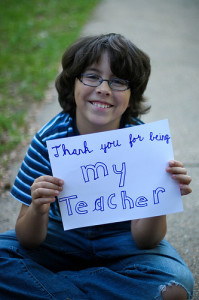When you give thanks, you grow
The results were clear: Higher levels of optimism, increased life satisfaction, and decreased negative feelings were all associated with students’ expressions of gratitude.
– Jeffrey Froh, Professor, Hofstra University
Recently, at dinner in our house, we went around the table and mentioned a few things we like about school, our work, our music lessons, our soccer practice, whatever…There aren’t any rules or expectations that we need to talk about loving math or writing, or commuting to work. The kids are free to say they like riding the bus or lunchtime, and I might mention an interesting discussion with someone at work. The point is simply to bring positive experiences, people, and moments to the forefront. And by retelling these experiences we reinforce them and associate these emotions with our work, school and learning experiences.
This kind of intentional thinking, reflection, and sharing of gratitude has demonstrated repeatedly in studies to be linked to helping individuals become socially effective communicators, proactive in building positive social interactions and developing higher levels of on-the-job, on-the-field, and in-the-classroom performance.
For example, Jeffrey Froh, Hofstra University, did this cool study in which he and his colleagues, tracked students in 11 classrooms, and divided them into three groups, asking them for just a few minutes each day to:
- Group 1. write down things they were grateful for at home and school
- Group 2. write down things they found to be a hassle and not fun (irritants)
- Group 3. a control group they asked nothing of
The first group wrote things like: “My coach helped me out at baseball practice,” “My grandma is in good health, my family is still together, my family still loves each other, my brothers are healthy, and we have fun everyday,” and “I am grateful that my mom didn’t go crazy when I accidentally broke a patio table.”
After two weeks, the researchers measured their school performance and engagement from both their perspective and the perspective of their teachers. Essentially, they found these students to be happier (by their own account), having more friends, and more engaged in their work (by the teachers account), and…wait for it, they got better grades – better in comparison to their own previous performance. That’s after only two weeks. The researchers checked in three weeks later after the study was over and found the effects to be still present.
In a powerful follow up study, students were asked to write a letter to a benefactor that feel they may have never properly thanked. It could be a teacher, a coach, or a family friend. The kids worked on their letters three times a week, for two weeks, elaborating on their feelings, and being increasingly specific in their writing about what the benefactor did that they were grateful for. On the friday of the second week, the kids set up a meeting with the person to read the letter, out loud, to that person face-to-face.
According to Jeffrey Froh, “It was a hyperemotional exercise for them. Really, it was such an intense experience. Every time I reread those letters, I get choked up.” And the positive outlook, and heightened engagement was still present when the researchers checked in with the kids 2 months later.
Maybe you can’t easily get your kids to write a letter of gratitude to someone in their life. Here’s a small and simple trick I learned from Dr. Karen Reivich, author of The Optimistic Child. Simply finish these sentences:
• ―Someone who helped me get through a difficult time is _______
• ―Someone who helped me learn something important about myself is _______
• ―Someone with whom I can discuss the things that matter most to me is _______




